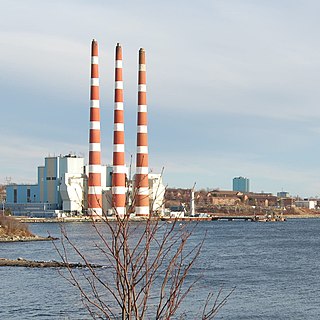
The Cape Breton and Central Nova Scotia Railway is a short line railway that operates in the Canadian province of Nova Scotia. CBNS operates of main line and associated spurs between Truro in the central part of the province to Point Tupper on Cape Breton Island.

The Sydney and Louisburg Railway (S&L) was a Canadian railway. Built to transport coal from various mines to the ports of Sydney and Louisbourg, the S&L operated in the eastern part of Cape Breton County, Nova Scotia. The railway uses a slightly different spelling for the town of "Louisbourg".
The Devco Railway was a Canadian railway. Devco Railway operated as an unincorporated department within the Coal Division of the Cape Breton Development Corporation, also known as DEVCO; as such there is no formally incorporated entity named "Devco Railway". Devco Railway took over the operations of the Sydney and Louisburg Railway on March 30, 1968 when DEVCO expropriated the S&L as part of the assets of the Dominion Steel and Coal Corporation, or DOSCO.

The Cape Breton Development Corporation, or DEVCO, was a Government of Canada Crown corporation. It ceased operation on December 31, 2009, after being amalgamated with Enterprise Cape Breton Corporation (ECBC).
The Sydney Coal Railway is a Canadian short-line railway operating in the eastern part of Cape Breton County, Nova Scotia.
Industrial Cape Breton is a geographic region in the Canadian province of Nova Scotia. It refers to the eastern portion of Cape Breton County fronting the Atlantic Ocean on the southeastern part of Cape Breton Island.
Nova Scotia Power Inc. is a vertically integrated electric utility in Nova Scotia, Canada. It is privately owned by Emera and regulated by the provincial government via the Nova Scotia Utility and Review Board (NSUARB). Nova Scotia Power Inc provides electricity to 520,000 residential, commercial and industrial customers in Nova Scotia.

The Dominion Steel and Coal Corporation was a Canadian coal mining and steel manufacturing company.
Point Tupper is a rural community in Richmond County, Nova Scotia, on the Strait of Canso, in western Cape Breton Island.

Tufts Cove Generating Station is a Canadian electrical generating station located in the Dartmouth neighbourhood of Tufts Cove in Nova Scotia's Halifax Regional Municipality.
Whitney Pier is an urban neighbourhood in Sydney, Nova Scotia, Canada. Prior to the 20th century, this area was known as “Eastmount” or “South Sydney Harbour,” and had long been a fishing and farming district. It is a triangle-shaped area North of the Muggah Creek estuary running along the Eastern shore of Sydney Harbour.
TrentonWorks is an industrial manufacturing facility located in the town of Trenton, Nova Scotia, Canada.
Lingan (is a Canadian suburban community in Nova Scotia's Cape Breton Regional Municipality. Its population in 2021 was 229.

The Lingan Generating Station is a 620 MW Canadian coal-fired electrical generating station located in the community of Lingan in Nova Scotia's Cape Breton Regional Municipality. Lingan is operated by Nova Scotia Power Inc. and is their largest generating station.

The Trenton Generating Station or Trenton GS is a 310 MW Canadian thermal generating station located in the town of Trenton, Nova Scotia.

Point Aconi is a rural community in Nova Scotia at the northeastern tip of Boularderie Island. It derives its name from the headland of the same name, Point Aconi.
Port Hastings is an unincorporated settlement on Cape Breton Island, within the Municipality of the County of Inverness, Canada. The population in 2021 was 90.

The Point Aconi Generating Station is a 165 MW Canadian electrical generating station located in the community of Point Aconi, Nova Scotia, a rural community in the Cape Breton Regional Municipality. A thermal generating station, the Point Aconi Generating Station is owned and operated by Nova Scotia Power Corporation. It opened on August 13, 1994 following four years of construction.
Victoria Junction is a community in the Canadian province of Nova Scotia, located in the Cape Breton Regional Municipality.

The Belledune Generating Station is a 450 MW coal-fired electrical generating station located in the community of Belledune in Gloucester County, New Brunswick. It is a thermal generating station owned and operated by provincial Crown corporation NB Power.











